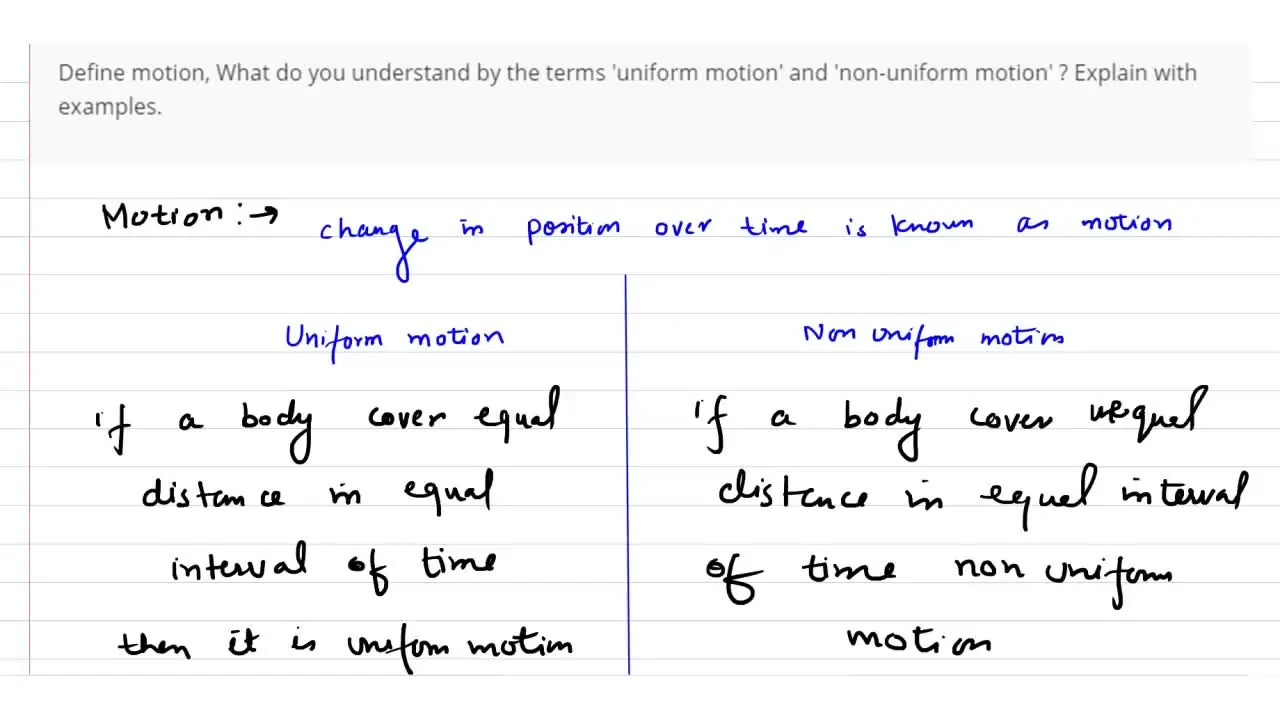Define motion, What do you understand by the terms 'uniform motion' and 'non-uniform motion' ? Explain with examples.
Define Law of Motion
Sir Isaac Newton was one of the most renowned scientists of all time. The three Laws of Motion by Newton describe the physical principles applied in the motion of massive bodies and how they interact with each other in motion or when in a fixed state.
Today many of us may think that Newton's laws of Motion are quite obvious, however, nearly three centuries ago they were considered as a groundbreaking innovation in Physics.
Here, we will learn about motion in Physics Definition, Equation of Motion for Uniform Acceleration, Formulas of Equation of Motion, Derivations of Equation of Motion and Law of Motion by Newton.
What is Motion?
In Physics, Motion can be defined as the change of position of an object with respect to time or change on the orientation of a body. A motion that brings a change in the orientation of a body is called rotation.
For example, an apple falling from the tree, a flying bird, moving train or second hand of the clock, etc. all exhibit motion.
All motions are relative to some frame of reference. A body may be in a state of rest, only means that it is being described as in rest with respect to a frame of reference that is moving together with the body.
Everything in the universe is in motion. It might be a small amount of movement, but the movement does happen. Remember, that even if you are sitting still, the earth is rotating at its own axis at all times (west to east) and it is also revolving around the sun.
Motion can be described in terms of the following terms:
- Distance
- Displacement
- Velocity
- Speed
- Acceleration
- Time
Equation of Motion for Uniform Acceleration
As said earlier, motion is the rate of change in position w.r.t time and it is described in terms of displacement, distance, velocity, acceleration, time and speed. The relations between these quantities will help us derive the equations of motion for a uniform acceleration.
The Three Equations are Tabulated Below:
Formulas of Equation of Motion
Equations of Motion
Formula
First equation of motion
v= u + at
Second equation of motion
s=ut+1/2at2
Third equation of motion
v2 = u2+2as
Here, s = displacement; u = initial velocity; v = final velocity; a = acceleration; t = time of motion.
Derivation of First Equation of Motion
It is known that the acceleration of a body, denoted by a, is defined as the rate of change of velocity. Therefore, we can write the acceleration (a) as:
- Acceleration = Change in velocity/Time Taken
- Acceleration = (Final Velocity-Initial Velocity) / Time Taken
Hence, a = v-u /t
or at = v-u
Now, rearranging the terms, The Newton’s First Law of Motion is obtained, which is:
- v = u + at
Derivation of Second Equation of Motion
We have, v = u + at. Therefore, we can write
- t = (v-u)/a
Likewise, we know that,
- Distance = average velocity × Time
Consequently, for uniform acceleration we can write:
Calculating Average velocity
= (final velocity + initial velocity)÷  2
2
= (v+u) ÷  2
2
Therefore,
- Distance (s) = [(v + u)/2] × [(v-u)/a]
- Or, s = (v² – u²)/2a
- Or, 2as = v² – u²
v² = u² + 2as is the Second Equation of Motion
Derivation of Third Equation of Motion
Let the distance be “s”. We know that
- Distance = Average velocity × Time
Also, Average velocity = (u + v)/2
Consequently, Distance (s) = (u + v)/2 × t
Also, from v = u + at,
We have:
s = (u + u + at)/2 × t = (2u + at)/2 × t
s = (2ut + at²)/2 = 2ut/2 + at²/2
Or
s = ut +½ at²
Law of Motion by Newton
Newton’s laws of motion help us understand the relations between the forces acting on a body and the motion of the body. Given below are three law of motion by Newton:
Newton’s First Law of Motion
It is also known as the Law of Inertia. It states that an object continues to stay in uniform motion in a straight line or in the state of rest unless it is acted upon by an external force.
Newton’s Second Law of Motion
Newton’s second law states that force is equal to the rate of change of momentum per change in time. Therefore, for a uniform mass, force equals mass multiplied by acceleration, i.e.
F = m x a.
Derivation of F = m x a
Let us consider an object of mass m is moving along a straight line with an initial velocity ‘u’. Now after a certain time t, with a constant acceleration, the final velocity becomes v.
Here we see that the initial momentum: P1 = m x u
And, final momentum P2 = m x v
Therefore, we can write the change in momentum as,
P2-P1 = (m x v) – (m x u)
Taking m common, P2-P1 = m (v – u)
As we know, the rate of change of momentum w.r.t. time is proportional to the applied force.
Therefore, force F ∝ (m x (v x u)) ÷ t
t
Above equation can also be simplified as, F ∝ m x a
F = k x m x a
Here, F = Force (in Newton’s, N)
k = constant of proportionality
m = Mass of the object (in Kg)
a = acceleration (acceleration in meters per second squared (m/s2)
Newton’s Third Law of Motion
Newton’s Third Law of Motion represents certain symmetry in nature. Sometimes, we also refer to this law as action-reaction law. Here the force applied is the action and the force felt is the reaction.
It can be better explained with the help of an example; we all know that the Earth pulls us down by applying the gravitational force.
What we don’t realize is that we are also pulling up the Earth. For example, if the Earth is pulling us down us with 5N of gravitational force, then we are also exerting the equal magnitude and opposite direction force on earth of 5N and pulling it up. It is a remarkable fact and is explained in Newton's third law.
Consider another example, let’s say a book is lying on a desk, even though the book is at rest it is actually exerting a force on the desk and the desk, on the other hand, is exerting equal and opposite force thus making the booking stay.
Equations of Motion
Formula
First equation of motion
v= u + at
Second equation of motion
s=ut+1/2at2
Third equation of motion
v2 = u2+2as
Related Playlists
- BOOK - LAKHMIR SINGH & MANJIT KAURCHAPTER - MOTION EXERCISE - SAMPLE PROBLEM1videos
MOTION
- BOOK - LAKHMIR SINGH & MANJIT KAURCHAPTER - MOTION EXERCISE - VERY SHORT ANSWER TYPE QUESTIONS3videos
MOTION
- BOOK - LAKHMIR SINGH & MANJIT KAURCHAPTER - MODEL TEST PAPER 5EXERCISE - Section B2videos
MODEL TEST PAPER 5
- BOOK - LAKHMIR SINGH & MANJIT KAURCHAPTER - SOUNDEXERCISE - Value Based Questions20videos
SOUND
Similar Questions
Explain the terms : uniform motion and non-uniform motion with examples.
View SolutionWhat is non-uniform motion ?
View Solutionwhat is uniform motion ?
View SolutionWhat is the difference between uniform linear motion and uniform circular motion ? Explain with examples.
View SolutionFor a uniform motion.
View SolutionUniform And Non Uniform Motion
View SolutionIn a non- uniform circular motion
View SolutionWhat is meant by uniform motion ?
View SolutionUniform circular motion is an example of
View SolutionHow is non-uniform motion different from uniform motion?
View Solution


